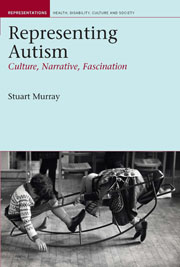Book contents
- Frontmatter
- Contents
- List of figures
- Permissions
- Preface: questions
- Introduction: autism and narrative
- 1 Presences: autistic difference
- 2 Idiots and savants
- 3 Witnessing
- 4 Boys and girls, men and women
- 5 In our time: families and sentiments
- Conclusion: causing/curing/caring
- Acknowledgements
- Select bibliography
- Index
1 - Presences: autistic difference
- Frontmatter
- Contents
- List of figures
- Permissions
- Preface: questions
- Introduction: autism and narrative
- 1 Presences: autistic difference
- 2 Idiots and savants
- 3 Witnessing
- 4 Boys and girls, men and women
- 5 In our time: families and sentiments
- Conclusion: causing/curing/caring
- Acknowledgements
- Select bibliography
- Index
Summary
To seek out the details of autistic presence in the very contemporary period might seem in some ways to swim against the tide. There is a precision to the term ‘autism’, in what we might think of as clinical terms, within the language of medicine, education and social care. As a diagnostic label, the condition is judged by set criteria. Those set out in the fourth (1994) edition of the American Psychiatric Association's Diagnostic and Statistical Manual of Mental Disorders (DSM–IV) are possibly the most well known. Here, impairments in social interaction and communication, language delay and repetitive behaviour are all put forward as characteristics necessary for the diagnosis to be arrived at. DSM–IV is a yardstick in the discussions of autism. Both accepted and contested, it aims for a degree of specificity in establishing what autism is. Yet the word (and label) has increasingly become untethered from this kind of attempt at precision. ‘Unfortunately’, Douglas Biklen writes in Autism and the Myth of the Person Alone, ‘metaphor is ubiquitous in the field of autism’. Biklen's observation is one arrived at after studying the work of autism specialists – neurologists and psychiatrists – but his comment is even more true of the wider world of commentary on the condition, where analogies abound. In one morning's casual browsing of autismrelated stories on the internet, I found an article on toxins that linked autism to the terrorist attacks on the US of 11 September 2001, and another protesting against the location of a new all-Ireland centre for the study of autism in Northern Ireland.
- Type
- Chapter
- Information
- Representing AutismCulture, Narrative, Fascination, pp. 27 - 64Publisher: Liverpool University PressPrint publication year: 2008

